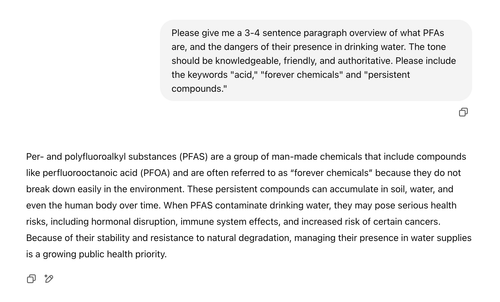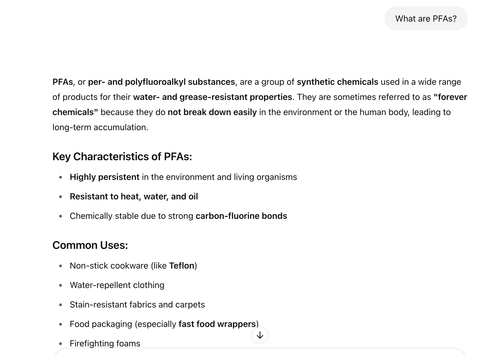Quality Control in AI-Produced Content: A Complete Guide
Zuletzt aktualisiert am
July 30, 2025
veröffentlicht:
July 30, 2025

By Jayne Schultheis — Have you been using AI to make content, but are concerned about the quality of what you're getting?
According to SurveyMonkey, 50% of marketers say they create content with artificial intelligence. But according to Salesforce, 39% of marketers aren’t sure how to safely use gen AI. There's a clear gap between a willingness to use the technology and confidence that it can be used safely, effectively, and realistically to make content processes better.
Indeed, poorly developed AI content can damage brand reputation and SEO performance. Let's take a deep dive into the importance of quality control when you work with AI-generated content. We'll talk about proven frameworks, processes, and checklists you can implement to maintain content excellence at scale.
Understanding AI content quality: It's more than just grammar and spelling
How does a content marketing company define quality in the era of AI models? Here's a framework:
Traditional quality metrics. Even in the AI era, the basics still matter. Accuracy, clarity, grammar, and consistent style are non-negotiable. No matter how advanced the tool, your audience still expects content that reads well and feels trustworthy.
SEO implications. Google's E-E-A-T guidelines might not be applied to your AI content, and you'll need to apply a creative process that makes sure your content is authoritative.
Quality vs. efficiency trade-offs. Automation is great for creating content quickly, but speed isn’t everything. Sometimes “good enough” just isn’t good enough, especially when credibility, trust, or brand reputation is on the line. Finding the right balance between productivity gains and true quality is where smart marketers stand out.
Hidden, AI-specific quality factors. Natural language processing is a powerful tool, but human oversight is necessary to deal with certain flaws, such as:
- Hallucination risks. AI sometimes creates convincing, but false information. Reliability is a risk factor.
- Context drift. AI loses track of key messaging or brand guidelines, and veers off course.
- Plagiarism. Generative AI is about data-scraping and re-packaging. And often, when it takes data, it doesn't give credit where it's due.
- Inconsistent voice. Maintaining brand personality across AI-generated pieces can be tough when you're working in batches.
- Bias. AI can unintentionally reinforce harmful stereotypes or skew perspectives based on the data it was trained on—something your audience will notice, even if the algorithm doesn’t.
- Factual verification. AI has time and knowledge cutoffs and issues with machine learning data quality.
Establish a quality control framework with this 4-step validation system
This might seem like a lot of work, but once you get into the groove and establish a quality control process within your AI content lifecycle, it'll become second nature.
Step 1: Pre-generation setup (foundation)
Before you get started with AI integration, take these steps to make sure the content is up to your brand's quality standards.
- Output specifications. Length, format, keyword density, and structural requirements should be clearly defined before hitting “generate.” The more specific you are about what the output should look like, the less time you’ll spend editing—or redoing content altogether.
- Documentation. Create AI-readable style guides and tone specifications to help maintain consistency across everything you publish. The clearer your documentation, the better the AI can align with your brand’s voice and expectations.
- Context windows. Provide relevant background information and constraints to keep the AI grounded in reality. Whether it’s a product description, past campaign copy, or audience insights, good context reduces fluff and improves accuracy.
- Prompt engineering. Thoughtful prompt engineering is essential for guiding tone, style, and voice. Don’t just ask for a blog post—set the scene, define the role the AI is playing, and give examples if needed. A well-crafted prompt can mean the difference between generic and on-brand.
Some platforms will allow you to put underlying parameters for all content. Some will let you customize underlying quality control parameters for each client. Free versions of content AI tools typically have limited capabilities in this realm, but you get what you pay for.
Check out how two different prompts can provide very different results in AI content generators:


Step 2: Real-time monitoring during generation (process)
These are things you can do during content generation:
- Multi-pass generation. Don’t settle for the first draft. Run 2–3 variations of the same prompt to compare tone, clarity, and structure. This gives you options and makes it easier to choose the strongest version or blend the versions.
- Progressive refinement. Use iterative prompting to improve quality step-by-step. Start broad, then zero in with follow-up prompts to sharpen messaging, tighten structure, and better match your brand voice. Keep track of your prompt tweaks and their effect on the output. A documented version history can help you understand what works, what doesn’t, and how to consistently generate higher-quality content over time
- Flag detection systems. Set up tools or processes that flag potential quality issues like repetition, hallucinations, or off-brand phrasing while the content is being generated. You can also build in intentional pauses, "checkpoints," during generation to review output against your quality standards. These checkpoints can help you catch issues early and steer the content before it goes too far off track.
- Structural validation. Make sure the final output follows proper formatting, heading hierarchy, and logical content flow. Even strong writing can fall flat if the structure is confusing or inconsistent. Good structure keeps readers engaged.
Step 3: Post-generation analysis (validation)
Now that you've generated the body of your content, you have some homework to do. These are some content moderation protocols you should implement for a comprehensive AI content audit.
- Check all links. Do the internal links prove your expertise within your niche? Do your external links go to authoritative, reputable sites?
- Plagiarism detection. Use tools and techniques beyond standard checkers.
- Brand alignment assessment. Score content against established brand guidelines.
- SEO optimization review. Apply technical SEO factors to AI-generated content. Are the sentences short enough? Do you have enough keywords integrated?
- Fact-checking protocols. Implement a verification process for claims and statistics.
- Keyword integration. Use natural keyword placement without stuffing.
- Readability scores. Maintain appropriate reading levels for target audiences.
- Human expert review. AI technology can do a lot, but it still needs a human partner to get things right, especially when accuracy and nuance matter. That’s where subject matter experts come in. Lean on their expertise when the content needs deeper insight or industry-specific validation.
After that, an editorial team steps in with a clear, consistent review process to polish grammar, style, and tone. It’s about making sure the content doesn’t just sound good—it sounds like you.
Step 4: Performance monitoring (optimization)
After your content is published, the marketplace (both readers and bots) will perform their own quality control assessment. Here's how to make the most of that feedback/data:
- Engagement metrics. Measure how AI-generated content stacks up against human-written pieces in terms of clicks, time on page, shares, and bounce rate. If it’s not connecting with your audience, it’s time to revisit the inputs.
- SEO performance. Track how your AI content ranks over time and what kind of organic traffic it’s bringing in. Search engines reward clarity and relevance, so good AI content should pull its weight in the SERPs.
- Conversion analysis. Look at how AI content contributes to lead generation, sign-ups, or sales. Performance here is the clearest signal that your content isn’t just getting attention, but driving action.
- Long-term brand impact. Pay attention to how your AI-generated content shapes brand perception over time. Is it supporting thought leadership, building trust, and staying consistent with your voice? If not, it may be doing more harm than good.
- Quality score trending. Track internal quality scores over time to see whether your AI content is improving or slipping. This can identify issues early and highlight which tweaks to your process are actually paying off.
- A/B testing. Regularly test different AI-generated versions of headlines, intros, or entire articles to see what resonates best. Small experiments can lead to big gains in engagement and conversion.
- Implement a feedback loop. Use performance data to refine how you prompt, edit, and deploy AI content. The more you learn from your audience’s reactions, the smarter your process becomes.
Industries that should pay special attention to AI content quality control
Some industries have higher stakes than others when it comes to publishing reliable, accurate information. People who write about public health, laws, and highly-technical subjects owe it to their readers to be trustworthy. Here are some fields that should take extra special care with quality control when it comes to AI ethics and content:
Healthcare and medical
- Regulatory compliance. You may be subject to FDA, HIPAA, and medical advertising requirements.
- Clinical accuracy. Create a verification process in place for health-related claims.
- Liability considerations. Keep a tight rein on risk management for medical advice content.
Financial services
- SEC compliance. The SEC is a stickler for investment advice and financial product regulations.
- Accuracy standards. Verify financial data and market information.
- Disclaimer requirements. Make sure you're using proper legal language.
Legal and professional services
- Ethical guidelines. Verify bar association rules for legal content marketing.
- Jurisdictional accuracy. Check state-specific legal information.
- Professional liability. Look closely into risk mitigation strategies with content, such as what words and terminology you need to avoid.
B2B technology
- Technical accuracy. Verify complex, technical concepts.
- Industry jargon. Check for appropriate use of specialized terminology.
- Thought leadership standards. If you're using AI content, it should still support expertise positioning.
Rellify can help your AI content meet its goals
Rellify’s platform, especially the Relliverse™, helps teams create AI-powered content that stays true to their brand voice, goals, and audience needs. With tools for building smart briefs and structured content plans, it improves accuracy, consistency, and search performance from the start.
We provide a practical way to produce high-quality content that builds authority and earns trust, both with your audience and in the search engine results pages. Ready to find out how? Schedule a brief (and free!) demo with one of our Rellify experts today.

